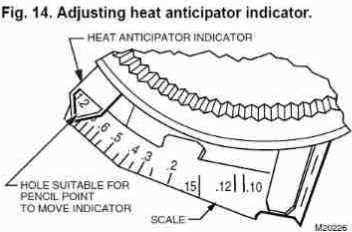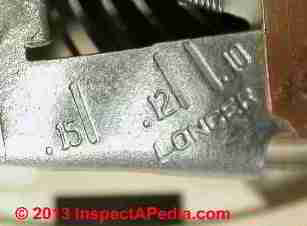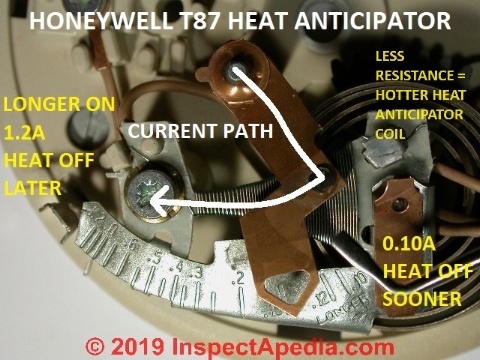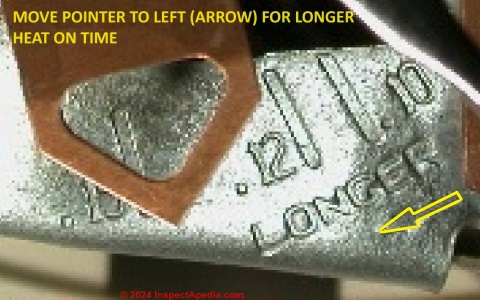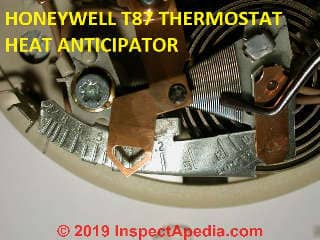 Thermostat Heat Anticipator Explanation
Thermostat Heat Anticipator Explanation
Which way & how much to move the heat anticipator pointer
- POST a QUESTION or COMMENT about heating thermostat heat anticipators
Simplified instructions for setting the heat anticipator in a Honeywell T87 and similar thermostats.
This article series explains what a heat anticipator is on a wall thermostat, where to find it, what it looks like, why we adjust the heat anticipator, how we do so.
We list the recommended heat anticipator settings.
InspectAPedia tolerates no conflicts of interest. We have no relationship with advertisers, products, or services discussed at this website.
- Daniel Friedman, Publisher/Editor/Author - See WHO ARE WE?
Thermostat heat anticipator operation, setting, tweaking - Ohms Law Explained
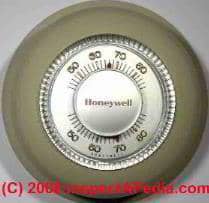 Honeywell's Instructions for Setting the Heat Anticipator
Honeywell's Instructions for Setting the Heat Anticipator
in a Honeywell Traditional T87 Thermostat
Using the Honeywell T87 Thermostat instructions (see [3a] inReferences or Citations ] as an example, and quoting:
If the T87F is used for 3-wire, spdt, heating-only (Series 20) control (Fig. 6), set the heat anticipator for 1.2 (far left end of scale). A fixed resistor-type heater is provided in the 137421A or 198170A Wallplate for this application.
For other control applications, proceed as follows.
Adjust anticipator to match current rating of primary control. Rating is usually stamped on the control name- plate.
Move the heat anticipator pointer or indicator to the marking that matches this rating.
The pointer may be moved with fingers or pencil point through the hole shown in in the figure below.
If the current rating is not given, proceed as follows before mounting the thermostat:
1. Connect an ac ammeter of appropriate range (0 to 2.0A, for example) between the R and W terminals on the wallplate or subbase
2. Let the system operate for one minute before read ing the ammeter.
3. Move the anticipator indicator to match the ammeter reading.
A slightly higher setting to obtain longer burner-on times (fewer cycles per hour) may be desirable for some systems. [3a]
According to Honeywell, set the heat anticipator to a lower number to let the heat run shorter
or make the room a bit cooler in relation to the set point on the thermostat by avoiding room temperature "overshoot" as additional heat arrives in the room by radiation from heating baseboards or furnace run-on time after the burner on the boiler or furnace has been stopped by the thermostat.
According to Honeywell, set the heat anticipator to a higher number to cause the burner to run longer
- with a longer on-cycle.
When we adjust the heat anticipator on a thermostat that has one, we are fine-tuning the amount of heat anticipation that the device is allowing.
Watch out:
Some modern DMMs that include a clamp-on ammeter might measure accurately down into the very few milliamp range that is needed, but most do not. In its instructions for using a mini milli-amp meter (described in detail
at HEAT ANTICIPATOR SET & TEST by AMMETER)
the company makes clear that a precise adjustment of a heat anticipator to a specific individual heating system installation needs to make a precise measurement of the current in the entire thermostat circuit.
Heat Anticipator Adjustment Direction & Settings - Honeywell CT87A,B,J Round® Thermostat
Using the Honeywell CT87A,B,J Round® Thermostat instructions (see [3b] inReferences or Citations ] as an example, and quoting:
NOTE: If the furnace stays on beyond the thermostat set temperature,
move the anticipator pointer down by .1 ampere.
If the furnace shuts off before the set temperature is reached, move the anticipator pointer up by .1 ampere.
Never adjust the anticipator below .3 ampere. [b]
You'll notice that the word "Longer" and the arrow shown in the earlier T87 Thermostat heat anticipator sketch [drawing above on this page] are not shown in Honeywell's line-drawing illustration but the word "LONGER" with or without a clarifying arrow appears in some of our photos of the actual heat anticipator. As we discuss below, an arrow below the word "LONGER" is hard to see, but it's there.
The explanation of which way to move the heat anticipator indicator for a longer burner on-time remains the same as for the T87:
for longer burner on time we want the heat anticipator to heat up less so that it warms the thermostat less, so we move move the heat anticipator indicator to a higher resistance number on the scale - more resistance means less heat will be generated by the "heat anticipator" winding. So the thermostat is "pre-warmed" less, so the actual heating boiler or furnace will stay on longer.
[Click to enlarge any image]
In our enlargement below, notice that below the word LONGER is an arrow pointing to the left!
Really? Honeywell was confusing as all getout in labeling of the heat anticipator on some thermostats.
In our photo above, notice that the word "LONGER" (we want the heater to stay on longer) is at the low-end of the resistance scale, under the .10 and .12 numbers.
But lower resistance means more heat will be generated, so the little coil in the heat anticipator will heat up the thermostat more, telling it to turn off sooner.
An arrow under "LONGER" is there, but very hard to see, even on the actual thermostat. The arrow points to the left, towards higher resistance numbers = less pre-heating in the thermostat = longer heat-on cycles. I've outlined the hard-to-see arrow in yellow.
I think Honeywell put the word "LONGER" and the left-pointing arrow on the "wrong" end of the scale simply because the mechanical design of the device gave enough space there for that text and arrow.
Heating System Type |
for the CT87 Thermostat |
|---|---|
Steam Heat |
|
Hot Water Heat |
|
High-Efficiency Warm Air Heat |
|
Standard Warm Air Heat |
|
Electric Heat |
|
Notes to the table above
Adapted, expaned and illustrated from Honeywell CT87A,B,J Round® Thermostat Low Voltage (15 to 30 VAC) Thermostat and Mounting Hardware Installation Instructions Honeywell Corporation, cited in detail
If the furnace stays on beyond the thermostat set temperature, move the anticipator pointer down by .1 ampere. That is, to a lower number.
If the furnace shuts off before the set temperature is reached, move the anticipator pointer up by .1 ampere. That is, to a higher number on the heat anticipator scale.
Watch out: Never adjust the anticipator below .3 amperes.
Below we've moved the pointer back over to 0.3 amperes on the heat anticipator scale.

This nice summary was provided by reader in a comment originally posted as a comment to the
article HEAT ANTICIPATOR ADJUSTMENT.
For a detailed explanation of how the thermostat heat anticipator actually works
see HEAT ANTICIPATOR OPERATION.
[Click to enlarge any image for more detail]
Reader Comments: why is there a heat anticipator?
12 April 2015 qprew7u said:
A furnace has two principal heat controls:
- The thermostat controls the gas valve on a gas fueled heater, or the oil burner's primary control / aquastat on an oil fired heating system.
- On a forced warm air furnace, the blower temperature switch controls the blower.
The furnace blower continues to run after the thermostat opens, for efficient heat exchange
On a furnace the blower is scavenging the remaining heat in the heat exchanger and it's avoiding heat exchanger damage that could occur if that component overheats and cracks.
QP's remarks describe forced warm air furnace heat but keep in mind that heat anticipators are used on hot water heating systems (baseboards and radiators) as well.
Any heating system: forced warm air, gravity warm air, hot water heat through radiators or baseboards, or steam heat, can "over-shoot" and continue to deliver more heat to the occupied space after the thermostat is satisfied.
A hot water heating system has different controls:
- The oil or gas burner on a hot water heating boiler is turned on or off by the temperature of the boiler water (via the boiler's Aquastast control)
- In U.S. installations the thermostat is turning the circulator on or off to send hot water to the spaces to be heated.
In Canada typically the circulator runs continuously and the thermostat is turning the boiler on and off directly. - Ed.
Only if the amount and duration that over-shoot is really a problem should you think about adjusting the heat anticipator. - Ed.
The heat anticipator “anticipates” that extra heat delivery by warming the thermostat to shut it off early.
The anticipator also creates hysteresis, so the furnace or boiler does not cycle too often.
QP means by hysterisis that we introduce a lag or delay between the change in room temperature and the response of the thermostat.
However the heat anticipator is only operating to turn the thermostat OFF a little "early". It does not introduce any delay when turning the thermostat back ON. - Ed.
Setting the Heat Anticipator:
The main reason for the anticipator adjustment is to match the thermostat with different furnaces.
From the factory the anticipator resistor is adjusted so that its warming effect (power dissipation) is nearly the same for different furnaces. That way the thermostat will behave the same way, no matter what furnace it is used with. But sometimes fine-tuning is needed as we explained above.
The heat anticipator is connected in series with the coil that energizes the gas valve [or turns on the hot water circulator if heat is by hot water].
The anticipator resistance is much lower than the resistance of the gas valve coil [or the circulator relay coil]. That means that no matter where the anticipator is adjusted, it does not appreciably affect the current in the circuit.
In other words, the current through the anticipator is constant for your furnace [or hot water boiler or steam boiler], no matter where the anticipator is adjusted.
The warming effect of the heat anticipator is
P = R x I**2
where
“P” is the power dissipated by the anticipator
“I” is the gas valve current rating in amperes, and
“R” is the anticipator resistor.
“I” is relatively constant for your furnace. “R” is adjusted to so that “P” is the nearly the same for different furnaces.
That is why the anticipator is calibrated in amperes, for easy matching to your furnace. It is also why some manufacturers refer to the adjustment as “fixed”.
Tweaking:
OPINION of QP: You can tweak the anticipator if you want to, but that is not the main reason for the adjustment.
Note: as we discuss
at HEAT ANTICIPATOR OPERATION there is some confustion between power and heat and current and watts.
That article gives a clear explanation of the relationship between electrical resistance and heat - the theory that explains why and how a thermostat heat anticipator works.
More details are at ELECTRICAL RESISTANCE vs HEAT GENERATED.
...
Reader Comments, Questions & Answers About The Article Above
Below you will find questions and answers previously posted on this page at its page bottom reader comment box.
Reader Q&A - also see RECOMMENDED ARTICLES & FAQs
Reader Question: which way to adjust the heat anticipator settings?
Chubby541 10/31/2012 said:
Lower heat anticipator settings:
According to Honeywell, setting the heat anticipator to a lower number (lower Amps number) setting will result in shorter burner on-cycles, ie less room-temperature overshoot.
A typical heat anticipator scale runs beetween a low of 0.10 Amps and a high of about 1.2 Amps.
Higher heat anticipator settings:
According to the manufacturer, a higher heat anticipator setting will result in less self heating of the thermostat, longer burner on-cycles, and possible overshoot of the room temperature. -
For an explanation of the relationship between electrical resistance and heat that thus explains how a heat anticipator adjustment works,
see ELECTRICAL RESISTANCE vs HEAT GENERATED.
Moderator Reply: heat anticipator setting numbers versus heat-on cycles
Thanks Chubby for prompting us to make sure that our explanation of the thermostat heat exchanger is precisely accurate and more clear.
As you can see in our closeup photo of the heat anticipator adjustment scale, the word "Longer" and an arrow are stamped into the end of the scale with the lowest number. The arrow points away from the low end towards the high end of the scale.
Honeywell is saying for a longer heat-on cycle (less heat anticipation) move the heat anticipator adjustment in the direction of the arrow - towards the higher amps end of the scale.
[Click to enlarge any image]
The heat anticipator is an electrical resistance heater that provides a tiny source of extra heat right inside the wall thermostat of some older room thermostats like the Honeywell T87 bimetallic spring mercury bulb model.
Heat anticipators are found in the T87® and the CT97A,T,J Round® room thermostats by Honeywell as well as in some other thermostat brands discussed here.
Making a little extra heat inside the thermostat means that the thermostat thinks the room is a little warmer than it actually is - which leads the thermostat to stop calling for heat a little early - hence the name "heat anticipator". The thermostat is anticipating that some additional heat will arrive into the room after it turns off the boiler.
More heat inside the thermostat means sooner burner off time (shorter burner on-cycles) and less room heat overshoot.
By Ohms Law, I = E / R or
- Current (Amps) x Resistance (Ohms) = Voltage = E
- Voltage / Resistance (Ohms) = Current (Amps) = I
- Voltage / Current (Amps) = Resistance (Ohms) = R
We can also write
- Volts x Amps = Watts
The relationship of electrical resistance to temperature is also derived from Ohms law and is written as follows, where (a) is the temperature coefficient of resistance: [23]
- a = 1 / Ro dRo / dT Ohms/Ohms/oC
Where for example watts can be giving us energy in the form of light, heat, or most likely a mix of the two.
This is true in general or simplified terms. A true "power" equation that relates power dissipation and current through electrical resistance P = IE ; P = I2R; is a little more complicated thanks to James P. Joule but we'll skip that more technically correct approach for this discussion.
Details are at DEFINITION OF AMPS, ELECTRICAL CURRENT
Reader Follow-Up: moving the heat anticipator to lower numbers gave shorter burner on-time
The Honeywell documentation is correct. Moving the anticipator to the RIGHT, i.e. LOWER current numbers, results in SHORTER cycle time. Why am I so sure?
1. Just tried it with my forced hot air system; moved from 0.8 to 0.4. It turns on/off twice as often now.
2. The current numbers on the anticipator aren't how much current it's generating (really, how would it do that?), it's how much current it's EXPECTING.
At lower settings, it is EXPECTING less current; since the amount of current the BOILER produces is constant, this results in more Joule heating of the anticipator and a faster cycle.
3. That "LONGER" text? Yeah, look more closely. It's got an arrow POINTING TO THE LEFT. It's too fuzzy to see in your picture; look on a real device. - C.K. 11/30/2013
The arrow does not point toward higher resistance, it points toward higher EXPECTED CURRENT (those are measurements in Amperes, as you correctly note!) and hence LOWER RESISTANCE: if the current coming from the boiler is HIGHER, the anticipator needs LESS resistance to produce the same amount of heat. (This is simply keeping I²R, i.e. the total heat output, constant.)
Example: boiler sends 0.4 A through the anticipator. If the anticipator is set to 0.8 A, it will heat up LESS (because it is expecting MORE current) and hence the cycle time will be LONGER than if the anticipator were set to 0.4 A.
I think the confusion in earlier versions of this article ("I can't explain this [yet] because at lowest resistance you'd think that we are not using the heat anticipator's resistor") stems from the assumption that moving the anticipator toward lower values uses less of the heating element, when in fact it is the other way around (to keep I²R constant).
It's not obvious from looking at a T87 which end of the resistance coil is connected (I would assume the small end, but you seem to assume the large end.)
Have you tested this with a multimeter?
Moderator Reply: exactly right: shorter wire, less resistance, more current flow, more heat anticipator heat output, earlier thermostat shutoff, shorter heat-on cycle
Thanks C.K. I'm not sure about your interpretation of "expecting" and anticipation, but Honeywell agrees with you about which way to move the heat anticipator setting for longer or shorter burner on-cycles.
Please click on any InspectApedia image to see a larger, more detailed image, including showing the arrow on the heat anticipator.
And in theReferences or Citations section of this article you can find a link to the installation instructions for the Honeywell T87F from which we quote above. I agree with you about the direction of the arrow you cite.
Lowering the heat anticipator to a lower number gives shorter heat-on times
Honeywell Corporation agrees that lowering the heat anticipator from 0.8 to 0.4 will give shorter heat on-times which, in turn, would typically result in more frequent burner on-off cycling - which is on an oil fired system and on some gas fired systems a less efficient way to run a heater.
\That's because lowering the Amps number from 0.8 to 0.4 cuts the current flow (Amps) in half, cutting the heat anticipator output accordingly.
By cooling the heat anticipator we stop pre-heating the thermostat's room temperature sensor as much.
By stopping the temperature sensor pre-heat we stop turning off the heat early.
We turn it off sooner.
That gives shorter on-imes and thus more frequent heat operation.
Raising the heat anticipator to a higher number gives longer heat-on times
In their T87 Honeywell states that a higher number on their heat anticipator scale gives a longer burner on-time.
That's because the heat anticipator pre-heats the thermostat less at higher Amps numbers, so the thermostat doesn't turn off "early" - it turns off "later" so the heating system will remain on longer.
A slightly higher setting to obtain longer burner-on times (fewer cycles per hour) may be desirable for some systems.
And again in their CT87A,B,J Round Thermostat instructions Honeywell also states that moving the heat anticipator up will give the burner a longer on time.
If the furnace shuts off before the set temperature is reached, move the anticipator pointer up by .1 ampere.
In preparing the original article and again in 2017 for confirmation of our understanding of heat and electrical resistance and thus of how the heat anticipator actually works, I checked with Dr. Jess Aronstein, an electrical engineer specializing in forensic work.
Here is his comment:
The anticipator heater operates with a constant voltage applied to it. When you decrease its resistance, at constant applied voltage, the current increases (E=IR).
The heat generated is proportional to the current squared times the resistance (heat = I-squared x R).
So if you set to half the resistance, the current in the active portion of the heating element is double the original, and the heat generated is the current squared times the resistance which calculates to double the heat relative to the original setting. - J. Aronstein to D Friedman, private email 2017/11/01
This is not a case of increasing the heat output by increasing electrical resistance in the circuit. It's the opposite.
On a thermostat that uses a heat anticipator, moving the anticipator's heating device sliding adustment to a higher Amps number (more current) will be seen to actually be using a shorter segment of the nichrome wire that comprises the heating element. That's actually lowering the resistance, permitting more current to flow, and generating more heat.
The numbers and resistance and heat effects in the original manufacturer's instructions can be a bit confusing.
In answer to your question of how the heat anticipator would know how much current it is generating, the anticipator is not generating current.
The heat anticipator is a variable resistor that varies by changing wire length. It is resisting current flow and generating heat. When we shorten the anticipator's wire length by moving the adjuster we are sending the same voltage through a lower-resistant shorter wire - the current flow increases and more heat is genearted.
The heat from the variable resistor warms the thermostat sensing bimetallic spring, thus fooling the thermostat into thinking the room is warmer than it actually is.
The heat anticipator is anticipating that additional heat is going to arrive in the room from water (or less-so by air flow).
We can measure resistance or current flow in Amps at different points along a wound resistance coil. The scale on the heat anticipator corresponds roughly to the position along the coil at which the moving contact touches the coil.
Moving the point of contact to a place where electricity has run through more wire means more resistance (less heat from the heat anticipator to warm up the thermostat), while less wire length means less resistance (so more heat is generated, the heat anticipator gets hotter so turns off the heater sooner) - Jaffee (1997).
Bottom line: by anticipating additional heat arrival
(hence the device name "heat anticipator") and by shutting off the burner a bit sooner than otherwise, the heat anticipator is reducing room temperature overshoot - warming the room higher than the thermostat requested.
Reader questions: physics of electrical resistance vs amps vs heat anticipators
(Feb 26, 2014) Bill Martino said:
When you raise the current value on your heat anticipator setting, according to Ohms law the resistance goes down as the amperage is inversely proportional to the voltage R=E/I which gives off less heat in the anticipator coil which allows the furnace or boiler to run longer
Reply:
Thank you for the clarification, Bill. This topic has generated many comments, which underscores how confusing it can be for some readers.
Longer burner on time has to be due to less heat coming off of the heat anticipator (less add-on warming of the thermostat's temperature sensor).
(Nov 17, 2014) RH in CT said:
What I find amusing about a thermostat with a heat anticipator is that a thermostat that is NOT controlling any sort of furnace or heat source, but which is adjusted to near the current temperature of the room, can cycle on and off despite the room temperature not changing.
Repy:
RH the thermostat should not be making you laugh - nor cycling on and off as you describe. I'd check further. Check for shorted thermostat wires.
Details are at ELECTRICAL RESISTANCE vs HEAT GENERATED
On 2020-01-22 by (mod) - which way is the heat anticipator current flowing?
Thanks so much Fab.
You are quite correct. Sitting on my lab desk is a Honeywell T87 mercury bulb type TT with a heat anticipator, dis-assembled for inspection. I'll post more of those photos ...
butIn photos of these thermostats don't just "look" at the apparent position of the mercury bulb and the position of the nichrome wire-wound variable resistor heat anticipator device.
One has also to follow the actual circuit, often a tiny brown wire that's mostly hidden under other components. When I'm back in the lab I'll expose those details in future photos to go along with your comment.
What adds to the confusion is that the company varied the direction of the scale, the shape of the variable resistor winding, which end was wide and which was narrow, etc. in various versions of the T87 over the years.
Both of your factoids are helpful.
Thank you.
On 2020-01-22 by fabrice002 - two observations explain how the heat anticipator works
Source of confusion stems from lack of a clear depiction of which end of the anticipator resistor is connected to the mercury switch. I could find that info nowhere! But it can be deduced from two factoids:
1) the anticipator resistor has virtually no influence on the controller current through the circuit.
2) Honeywell literature indicates the anticipator resistor delivers approximately the same amount of heat to the bi-metal strip when the current setting corresponds to the control circuit amperage, in order for the thermostat to be useful for the widest variety of control systems.
Therefore the highest current position (small end of the resistor) must connect to the mercury switch so it doesn't over-heat the bimetal temp sensor.
Therefore, current flows from the contact point on the resistor to the small end of the resistor to the switch.
The other large end is not connected.
On 2019-05-19 by IkeE - does the heat anticipator affect air conditioning ?
How does anticipater affect air conditioner?
On 2019-05-19 by (mod) - no
No Ike a heat anticipator ought to be off when there is no call for heat.
...
Continue reading at HEAT ANTICIPATOR OPERATION or select a topic from the closely-related articles below, or see the complete ARTICLE INDEX.
Or see these
Recommended Articles
- AMPS MEASUREMENT AUTOMOTIVE DC
- AMPS MEASUREMENT METHODS
- BOILER CONTROLS & SWITCHES
- DEFINITION OF AMPS, ELECTRICAL CURRENT
- DEFINITION OF OHMS, ELECTRICAL RESISTANCE
- ELECTRICAL RESISTANCE vs HEAT GENERATED
- FURNACE CONTROLS & SWITCHES
- HEAT ANTICIPATOR ADJUSTMENT
- HEAT ANTICIPATOR ADJUSTMENT - T87
- HEAT ANTICIPATOR EFFECTS on ROOM TEMPERATURE
- HEAT ANTICIPATOR OPERATION
- HEAT ANTICIPATOR SET & TEST by AMMETER
- HEAT ANTICIPATOR THERMOSTAT SOURCES
- HEAT WON'T TURN OFF
- STEAM HEATING SYSTEMS
- TEMPERATURE RESPONSE of ROOM THERMOSTATS
- THERMOSTAT WIRE CONNECTIONS
- VOLTS / AMPS MEASUREMENT EQUIP
Suggested citation for this web page
HEAT ANTICIPATOR ADJUSTMENT - T87 at InspectApedia.com - online encyclopedia of building & environmental inspection, testing, diagnosis, repair, & problem prevention advice.
Or see this
INDEX to RELATED ARTICLES: ARTICLE INDEX to HVAC THERMOSTATS
Or use the SEARCH BOX found below to Ask a Question or Search InspectApedia
Ask a Question or Search InspectApedia
Try the search box just below, or if you prefer, post a question or comment in the Comments box below and we will respond promptly.
Search the InspectApedia website
Note: appearance of your Comment below may be delayed: if your comment contains an image, photograph, web link, or text that looks to the software as if it might be a web link, your posting will appear after it has been approved by a moderator. Apologies for the delay.
Only one image can be added per comment but you can post as many comments, and therefore images, as you like.
You will not receive a notification when a response to your question has been posted.
Please bookmark this page to make it easy for you to check back for our response.
IF above you see "Comment Form is loading comments..." then COMMENT BOX - countable.ca / bawkbox.com IS NOT WORKING.
In any case you are welcome to send an email directly to us at InspectApedia.com at editor@inspectApedia.com
We'll reply to you directly. Please help us help you by noting, in your email, the URL of the InspectApedia page where you wanted to comment.
Citations & References
In addition to any citations in the article above, a full list is available on request.
- Jaffe, James S, THERMOSTAT HEATERS [PDF], Fueloil & Oil Heat with Air Conditioning, February 1997
Excerpt:
If you look inside most thermostats at the anticipa- tor, you will see a coil of thin wire (some use a fixed resistor to do the same job). That coil is the heater. When the thermostat calls, it closes a switch complet- ing a circuit to allow current to pass through it. When current passes through the coil, the coil creates resis- tance, resistance creates heat. Heat from the coil warms the thermostat. The more current that passes through the coil the more heat it makes and vice versa. That is why it is important to set the anticipa tor appropriately for the amp draw of the controlled device and not adjust it by, say, how far it is from the baseboards. - [1] Proliphix Corporate Headquarters [Website: proliphix.com] , 3 LAN Drive Suite #100, Westford, MA 01886 Phone: +1.978.692.3375 Toll Free (U.S.): 866-IP-LIVING (866.475.4846) Fax: +1.978.692.3378 - Sales: sales@proliphix.com Marketing: marketing@proliphix.com Customer support: support@proliphix.com http://www.proliphix.com/
- [2] "The Nest Learning Thermostat", Nest Thermostat, 900 Hansen Way Palo Alto, CA 94304, Tel: 855-4MY-NEST, Email: info@nest.com, website http://www.nest.com/, retrieved 1/24/2013.
- [3] Honeywell Controls, the company wants you to use their contact form at this web page: http://www51.honeywell.com/honeywell/contact-support/contact-us.html
Honeywell Consumer Products, 39 Old Ridgebury Road Danbury, CT 06810-5110 - (203) 830-7800
World Headquarters, Honeywell International Inc., 101 Columbia Road, Morristown, NJ 07962, Phone: (973) 455-2000, Fax: (973) 455-4807 1-800-328-5111 - [3a] Honeywell Tradeline T87T Universal Thermostat Installation Instructions for the Trained Service Technician", Honeywell International Inc. Honeywell Limited—Honeywell Limitée 1985 Douglas Drive North 35 Dynamic Drive Golden Valley, MN 55422 Scarborough, Ontario M1V 4Z9, 60-0830—4 G.H. Rev. 8-02, retrieved 12/1/2013 Website: www.honeywell.com
- [3b] Honeywell CT87A,B,J Round® Themostat Low Voltage (15 to 30 VAC) Thermostat and Mounting Hardware Installation Instructions, Honeywell International Inc. Honeywell Limited—Honeywell Limitée 1985 Douglas Drive North 35 Dynamic Drive Golden Valley, MN 55422 Scarborough, Ontario M1V 4Z9, 60-0830—4 G.H. Rev. 8-02, retrieved 12/1/2013 Website: www.honeywell.com
- [4] White Rodgers Thermostats and HVAC controls,
Homeowner information: http://www.emersonclimate.com/en-US/brands/white_rodgers/Pages/wr-homeowner-info.aspx
Contractor information: http://www.emersonclimate.com/en-US/brands/white_rodgers/wr_contractor_info/Pages/white-rodgers-contractor-info.aspx
White Rodgers Product Catalog (don't misspell the company's name as White Rogers Thermostats) -
http://www.emersonclimate.com/Documents/thermostats.pdf - Thermostat Catalog - [5] Domestic Central Heating Wiring Systems and Controls, 2d Ed., Raymond Ward, Newnes, ISBN-10: 0750664363, ISBN-13: 978-0750664363
- In addition to citations & references found in this article, see the research citations given at the end of the related articles found at our suggested
CONTINUE READING or RECOMMENDED ARTICLES.
- Carson, Dunlop & Associates Ltd., 120 Carlton Street Suite 407, Toronto ON M5A 4K2. Tel: (416) 964-9415 1-800-268-7070 Email: info@carsondunlop.com. Alan Carson is a past president of ASHI, the American Society of Home Inspectors.
Thanks to Alan Carson and Bob Dunlop, for permission for InspectAPedia to use text excerpts from The HOME REFERENCE BOOK - the Encyclopedia of Homes and to use illustrations from The ILLUSTRATED HOME .
Carson Dunlop Associates provides extensive home inspection education and report writing material. In gratitude we provide links to tsome Carson Dunlop Associates products and services.


